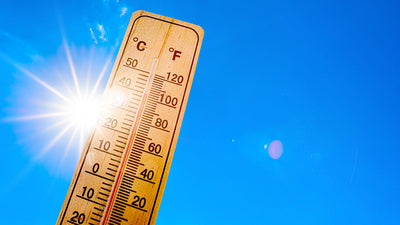How Does Climate Change Impact Drinking Water?
RSS
Emily Driehaus | Science Communication Intern
Recent IPCC reports provided a look into how climate change has altered global temperatures and weather patterns over the past few decades. The International Panel on Climate Change publishes a "state of climate change" every few years that provides update on how today’s emissions and activities will affect weather patterns in the future, and the effects these changes will have on our lives. The report highlighted how climate change has and will continue to impact the accessibility of clean drinking water.
Why This IPCC Report is Different From Previous Years:
The recent IPCC findings are notable because scientists have determined that it is “unequivocal that human influence has warmed the atmosphere, ocean and land.” The term “unequivocal” is not used lightly in this instance, as scientists do not use absolutes unless the evidence is unquestionable.
Scientists also used paleoclimate data to provide more context for our current period of warming. Our planet goes through glacial and interglacial periods, where a glacial event is followed by a period of time where the climate is warmer. We are currently in an interglacial period after the last glacial period ended about 11,000 years ago. The last interglacial period before our current interglacial occurred about 125,000 years ago. The IPCC report found that “the last decade was more likely than not warmer than any multi-centennial period after the Last Interglacial.” To put this in perspective, Homo sapiens were still mostly living on the African continent 125,000 years ago. The past decade has likely been warmer than any multi-centennial period since Homo sapiens migrated out of Africa and dispersed across the globe.
The IPCC report also included new advances in a branch of climate science known as attribution science. Scientists can now attribute specific weather events to human-induced climate change. In other words, the frequency of extreme weather events, like droughts and hurricanes, is a direct result of human-driven climate change.
The authors of the report included a glimpse of what the future might look like under five different climate scenarios with greenhouse gas emissions ranging from “very low” levels to “very high” levels. Some effects of climate change are now unavoidable and are present in all scenarios, but the intensity of these events is increased as greenhouse gas emissions climb. For example, global surface temperatures will continue to increase in all the presented scenarios, but the degree of warming increases with each climate scenario. Global warming of 2° Celsius is very likely to occur under the “very high” emissions scenario, but is extremely unlikely to be exceeded under the “very low” emissions scenario. These scenarios provide important perspectives on what the future of our planet could look like under different emissions scenarios, as changes in weather patterns will become more extreme with each increment of warming.
What Does All This Have To Do With Drinking Water?
Extreme weather events already have an impact on our drinking water. Droughts reduce the amount of drinking water available due to the lack of precipitation to replace water supplies. Water contamination is also more likely to occur in areas with drought conditions. Hurricanes and tropical storms can also contaminate drinking water supplies with floodwater and leave communities without clean drinking water for long periods of time. Even cold weather events can affect access to clean drinking water, especially in areas that are not equipped with the infrastructure to deal with extremely cold temperatures. For example, the recent round of winter storms that brought freezing temperatures to Texas limited access to drinking water due to frozen pipes, power outages, and boil water advisories.
As global temperatures increase, these extreme weather events will increase not only in frequency but in intensity as well. Drinking water supplies will be threatened by these events more often and the intensity of these events risks damaging water infrastructure that was not built to withstand the extreme weather conditions created by climate change.
The IPCC report also included specifics on how global warming will directly impact the global water cycle. Like weather patterns, the rise of global temperatures will intensify the water cycle, making wet seasons wetter and dry seasons drier. This will have direct implications for areas of the world that depend on seasonal precipitation. Intensified dry seasons will impact agriculture and those who depend on rainy seasons to water their crops. Intensified wet seasons bring the risk of flooding that could potentially damage communities and infrastructure. These intensified seasons will also bring problems with drinking water quality, either due to lack of rainfall to replenish water supplies or too much precipitation that contaminates drinking water supplies with dirty floodwater.
How Can We Stop The Worst From Happening?
It is easy to fall into a downward spiral of negative thinking after reading about how our planet is being irreversibly damaged. However, this report makes it clear that there is still time to change course. While it is too late to stop some warming from occurring, there is still time to cut greenhouse gas emissions and prevent the worst from happening. Now is the time to call on world leaders and governments to implement policies that will lower emissions and protect future generations and ensure a livable planet with access to clean drinking water for all.




